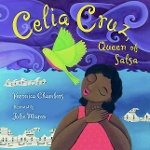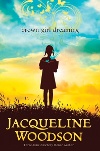AfroLatin@ Children's Literature, Education, and the Black Diaspora
While working as a young adult information assistant at the Countee Cullen Library, located behind the Schomburg Center for Research in Black Culture in New York City, I visited the James Weldon Johnson Reference Collection, on the children’s floor. The collection consists of an impressive array of Black children’s books, which I would peruse during my break. At one point I was looking for books by and/or about AfroLatin@s for children...
While working as a young adult information assistant at the Countee Cullen Library, located behind the Schomburg Center for Research in Black Culture in New York City, I visited the James Weldon Johnson Reference Collection, on the children’s floor. The collection consists of an impressive array of Black children’s books, which I would peruse during my break. At one point I was looking for books by and/or about AfroLatin@s for children. I thought I’d find Veronica Chambers’s Celia Cruz, Queen of Salsa, about the famous AfroCuban singer. Or Junot Díaz’s Islandborn, about a Black Caribbean girl who migrates to the United States but can’t remember the island she came from. Or Edwidge Danticat’s Eight Days: A Story of Haiti. Stories such as these, which touch on Black lives and Black migration, were missing — and yet these stories are vital to the body of work that encompasses AfroLatin@ literature in the United States.



In this country, Black people experience overt forms of racism. This is not limited to Black Americans, per se — AfroLatin@s, as Black people, experience it, too. In this sense, integrating Black American and AfroLatin@ education is not just a matter of identity. Black unity is also a form of advocacy that, working together, resists and combats institutional racism, creating a space that centers the diversity of Black experiences.
As data shows, most U.S. teachers are not Black. Nor do most existing curricula highlight or center Black experiences. Furthermore, many educators are still treating Blackness and Latinidad as mutually exclusive, thereby further dividing Black American and AfroLatin@ communities. This can be seen when schools continue to tell stories of Black History Month and Hispanic Heritage Month as separate histories. More importantly, Black American histories are often told as entirely separate from AfroLatin@ ones. For instance, Max Brooks’s graphic novel The Harlem Hellfighters depicts the story of the all-Black 369th regiment and segregated band, which gained fame during World War I. Brooks offers no mention of the Afro-Puerto Rican musicians who made up one-third of the band, such as Rafael Hernández Marín, who was instrumental in the introduction of jazz to European audiences. It was not until seeing Marín’s name in The Afro-Latin@ Reader: History and Culture in the United States, a book for adults, that I learned about his contribution to the Harlem Hellfighters.
This is just one example of overlooked AfroLatin@ stories that could naturally be incorporated into Black American history. In my imagination, if the James Weldon Johnson Reference Collection did own the titles at left — incorporating diasporic Blackness — the children’s librarians could read Celia Cruz, Queen of Salsa during storytime while showing a map of the Atlantic, where they could trace Cruz’s journey between Cuba and the United States. They could incorporate images by African American artist Jacob Lawrence, thereby emphasizing multiple Black migrations and giving children a sense of how Black people in the diaspora move throughout the world.
Some Black diasporic educators are using creative methods to explore these connections, emphasizing Black migrations and intersecting Black stories, and thereby challenging Black singular experiences and identities. During the pandemic, Peter Limata, who is from Zambia and a first-grade teacher in Oakland, California, began “Story Time with Mr. Limata” on Facebook Live. Every weekday at 10:30 a.m. PT, he shares a story of joy, providing students with continuity and enhancing their learning experience alongside friends and neighbors. There is a real impact to be made on young students and families as they see and engage with Black diasporic educators taking center stage on their screens. Brayan Guevara, an Afro-Latino elementary school teaching assistant in Greensboro, North Carolina, serves as a model for his community by centering AfroLatin@ migrant children in his pedagogical practice. AfroLatina Costa Rican (by way of Brooklyn) Angeley Crawford, who is a Spanish teacher in Washington, DC, includes AfroLatin@ identity and history in her teaching. Students learn about what Black unity looks like across borders and explore how multiple identities of class, gender, sexuality, ability, and citizenship status play roles in what freedom and access looks like for AfroLatin@s.
 Carole Boston Weatherford’s Schomburg: The Man Who Built a Library is an excellent example of a book that serves as a bridge for Black diversity. Highlighting Schomburg’s life as an Afro-Puerto Rican bibliophile during the Harlem Renaissance, Weatherford touches on the importance of his work to the greater Harlem community, encompassing such writers as Zora Neale Hurston, Langston Hughes, and Alain Locke, among others.
Carole Boston Weatherford’s Schomburg: The Man Who Built a Library is an excellent example of a book that serves as a bridge for Black diversity. Highlighting Schomburg’s life as an Afro-Puerto Rican bibliophile during the Harlem Renaissance, Weatherford touches on the importance of his work to the greater Harlem community, encompassing such writers as Zora Neale Hurston, Langston Hughes, and Alain Locke, among others.
 The ability to reclaim their Black histories for AfroLatin@ young people is fundamental for developing a Black consciousness early on. On the YA landscape, Daniel José Older’s Shadowshaper focuses on a young Afro-Puerto Rican woman, Sierra Santiago, who has the ability to infuse art with ancestral spirits. Older’s approach to Black ancestry is important as it allows AfroLatin@ teens to reclaim Black history as a source of empowerment, instead of AfroLatinidad serving as merely an extension of Latinidad.
The ability to reclaim their Black histories for AfroLatin@ young people is fundamental for developing a Black consciousness early on. On the YA landscape, Daniel José Older’s Shadowshaper focuses on a young Afro-Puerto Rican woman, Sierra Santiago, who has the ability to infuse art with ancestral spirits. Older’s approach to Black ancestry is important as it allows AfroLatin@ teens to reclaim Black history as a source of empowerment, instead of AfroLatinidad serving as merely an extension of Latinidad.
I also envision teens concurrently reading Elizabeth Acevedo’s The Poet X, about an AfroLatina teen in New York, and Jacqueline Woodson’s Brown Girl Dreaming, about the author’s own experiences as an African American young person in Ohio, South Carolina, and Brooklyn. Both written in verse, they explore the struggles of Black young women, through very different details but fascinating overlap that can foster discussion.


We have to also think about diverse Black stories and histories that do not fit one mold. For example, the history of the Underground Railroad going south to Mexico; or, in contemporary times, African refugees migrating to such cities in Texas as Laredo and San Antonio, by way of Mexico. This helps us understand that AfroLatin@s and AfroLatinidad are not a bridge between non-Black Latin@s and Black Americans: to think of them as such would be to assume that they must be the cultural or racial brokers between Black Americanness and non-Black Latinidad. It is not the responsibility of AfroLatin@s to explain or translate Blackness or anti-Blackness to non-Black people. Instead, these books and necessary changes in our curricula serve as starting places to bring people together through an anti-racist framework that highlights diverse Black stories.
Black stories are a necessity in order to demonstrate what Black unity can look like. As Black immigration continues to increase in the United States, we must advocate for Blackness as a diasporic experience. The future generations of all backgrounds would benefit from understanding Black diversity at a young age. Instead of simplifying Black stories to make them accessible to everyone, we should be complicating those narratives in order to uncover new ways of belonging and creating community. AfroLatin@ children’s and young adult books are becoming a watershed for Black liberation and communalism, but it is up to us and our communities to pave the way for these connections to be made.
From the May/June 2021 special issue of The Horn Book Magazine: The Pura Belpré Award at 25.

RELATED
ALREADY A SUBSCRIBER? LOG IN
We are currently offering this content for free. Sign up now to activate your personal profile, where you can save articles for future viewing.







Add Comment :-
Be the first reader to comment.
Comment Policy:
Comment should not be empty !!!